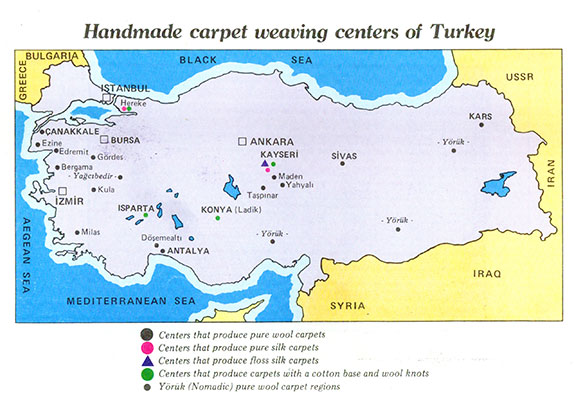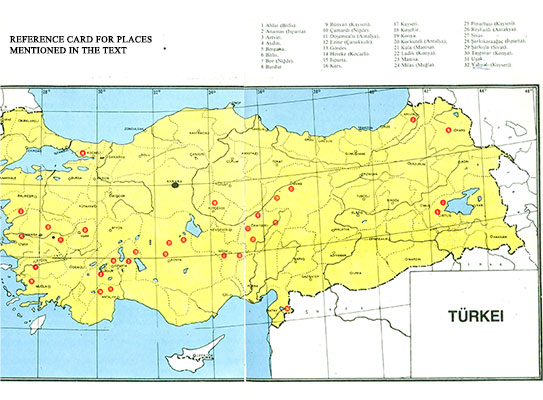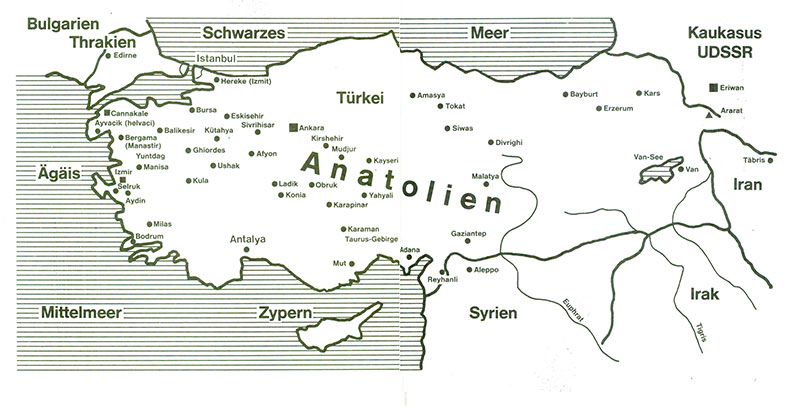Techniques of Carpet
Precious handmade carpets are the products of long months of labor requiring great skill and patience. Besides being utilitarian objects, they are a source of pleasure to their owners.
A beautiful carpet is like a fine painting; it holds the eye. It is also an investment which will retain its value as the years pass.
Contemporary Turkish carpets are made by local masters who use materials and designs characteristic of the region in which they work. After careful checking for quality and a first washing, these carpets enter the domestic and foreign markets through the hands of famous dealers.
This online site is an illustrated guide to contemporary Turkish carpets region by region.
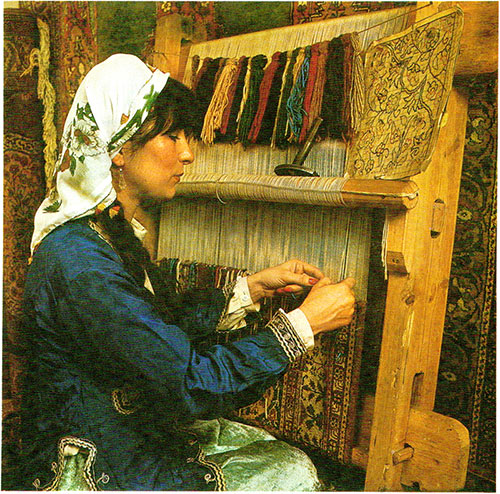
Carpet - weaving loom
Until recent times all artifacts had to be handmade, but modern technology and mass production have replaced skills and techniques traditional for thousands of years. In our day handmade works are rare, and among them are the beautiful and functional knotted carpets made using traditional methods developed for over 2000 years.
Carpets, whose weaving can take months or even years of skill and effort, are pieces that can be kept and handed down from one generation to another, gaining in value as their antiquity increases. Each region has its own techniques and traditional designs practiced by its anonymous artists.
Carpet weaving and making is collective work using skills passed on for generations. Families, tribes, or even whole villages work collectively, pooling their special skills, knowledge,and expertise. The methods of manufacture and the different raw materials used produce distinctive carpets, characteristic of the region in which they are woven.
Handmade knotted carpets are used for various purposes by the local people in their region of origin. Besides being used as rugs, carpets serve such purposes as tent screens, paintings, cradle and sofa covers, wall hangings, and prayer rugs.
A beautiful high-quality handmade carpet increases in value as it is used; for the carpet’s knots tighten in use,making it more brilliant and treasured.
Private collectors, distinguished families, and museums are proud owners of antique carpets. The richest collections of antique knotted handmade carpets are to be found at the İstanbul Museum of Turkish and Islamic Arts, the Vakıf Carpet Museum in the Blue Mosque, and the Konya Mevlana Museum. The museums and collectors of Europe and the USA own some exquisite pieces, most of which have been exported from Turkey. During the 14th, 15th and 16th centuries, handmade Turkish carpets were prized possessions of the noble and wealthy families of Europe. Carpets of this era, which have survived,have taken their places in museums.
For the last century or more, handmade knotted carpets have been a subject of research for experts and art historians. Great numbers of books and journals have appeared on the subject, showing that the making of handmade carpets is an important art form. The spread of knowledge through such publications has caused an increased demand for fine carpets.
Authorities conclude that the making of knotted carpets, produced in an area extending from the Mediterranean coast of Turkey to the steppes of Central Asia, was introduced by Turkish nomadic tribes and craftsmen. Traditional Turkish carpet making with its distinctive techniques, materials, patterns, and knotting has had a great influence upon all oriental carpets. In art history books, one comes across carpets that date back to the ancient. Persian, the Pharoahs, and the Calips. However, these were not knotted carpets, but were rugs woven using the simple “towel technique” instead of knotting.
The hard-wearing double-knotted carpets are the invention of Turkish tribes. The techniques found in handmade carpets were brought to the Mediterranean coast by the Seljuks in the 12th century. Marco Polo mentions rich exhibits of carpets in palaces and mosques. Carpet making has developed at different speeds in different periods according to demand, but high-quality handmade carpets have always found a ready market.
Carpets are textile products; Turkish handmade carpets have always had patterns which fitted the specific nature of the materials and the knotting used. Another special characteristic of Turkish handmade carpets is the use of the double knot, known as the Turkish or Gördes knot. Although designs and patterns change and develope,the Turkish carpet always retains its historical and traditional features.
The carpets shown in this book are knotted handmade rugs woven mostly by the womenfolk of the regions.
The first step in carpet making is to have a pattern or a design. Master weavers do not need a pattern outline, but retain the pattern in their memories. The second step involves the choice of material. Materials used differ according to type and region. The material of a carpet may be wool, pure silk, floss silk,or cotton. The pure silk of Turkish carpets is produced from the cocoons grown in Bursa, one of the few silk centers of the world. Silk carpets are ideal ornaments, and may be used as tapestry, wall hangings,and for other decorative purposes.
The material most commonly used is sheep’s wool. The Anatolian plateaus are excellent grazing land for sheep and good grazing land determines the sheen and strength of the wool.
Cotton is used in the weaving of a base (warp and weft) for the carpet and wool is then knotted on to this to form a pile. Carpets made with cotton and wool are as hard wearing, beautiful, and attractive as other carpets.
In carpets manufactured only in the Kayseri region, floss silk, which is a kind of artificial vegetal silk, is used. Floss silk makes up the pile knots of the carpet’s cotton base system. It is as strong as other materials and is also easily dyed, making possible the production of a wide range of colors.
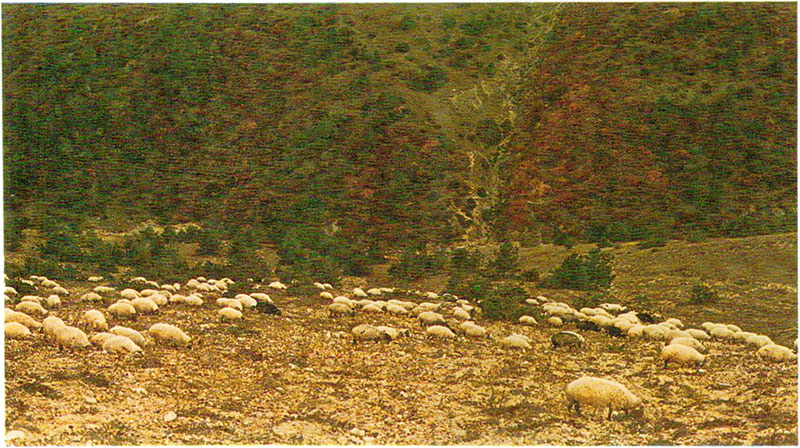
Flock of sheep on high-plains
Knotted carpets are woven on a loom consisting of horizontal bars on which the warp and weft threads are stretched. Onto these threads the pile knots are tied according to a pattern. The thread ends which make up the pile are clipped off so as to get a velvet-like soft surface. Thus the motifs are made up of thousands of individual knots. The tighter the knots, the finer and stronger is the carpet. The pleasure one gets from a beautiful carpet equals the pleasure one gets from a beautiful picture.
The double knot, known as the Turkish or Gördes knot, is used in all typical Turkish carpets. Another well-known system is the Sehna or Persian knot. The Turkish knot is wrapped around two warps and the Persian knot around a single warp. A kilim, which is similar to a carpet, is woven on the loom but with a different technique; knots are not used and it is woven normally.
The Gördes knot makes a carpet stronger, firmer and more durable, while the Sehna knot allows the weaving of varied patterns. However, once p carpet is made it is difficult to determine the knotting system.
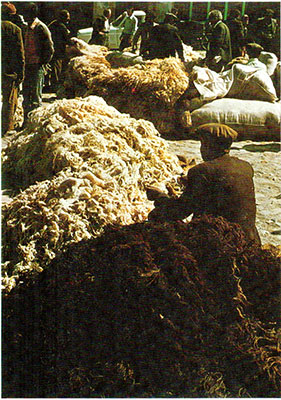 |  |
| Raw wool market | Spinning of wool thread on spindle |
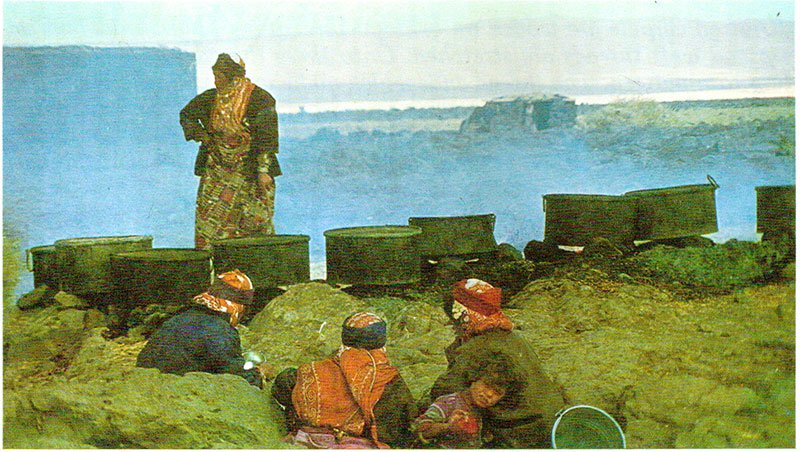
The colors also are characteristic of the region where the carpet is made. The threads used in the weaving of antique carpets were used to be dyed with natural dyes known only by the family that manufactured the carpet. Today chemical dyes are used along with vegetal dyes. Natural dyes are produced from leaves, roots, and fruits. Many of the villages engaged in carpet making have a grazing land called “Boyalık”. Plants from which dyes are produced are grown there. The various formulas for dye production have been passed down from generation to generation. Thus the colors traditional to Turkish carpet making have survived till our day. Red is dominant in Turkish carpets. This striking color expresses wealth, joy and happiness.
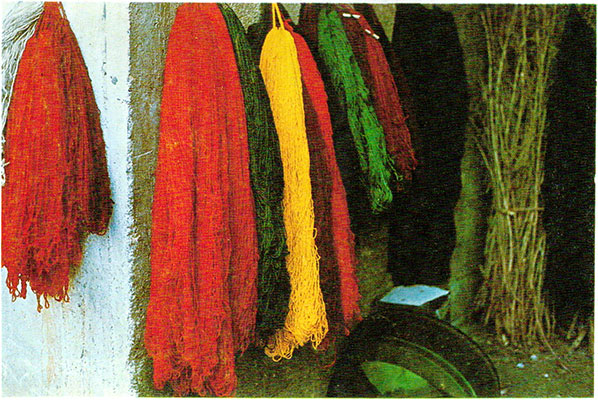
Dyed wool hanks
Green sybolizes heaven; blue nobility and grandeur; yellow is believed to keep evil away, and black symbolizes purification from worries.
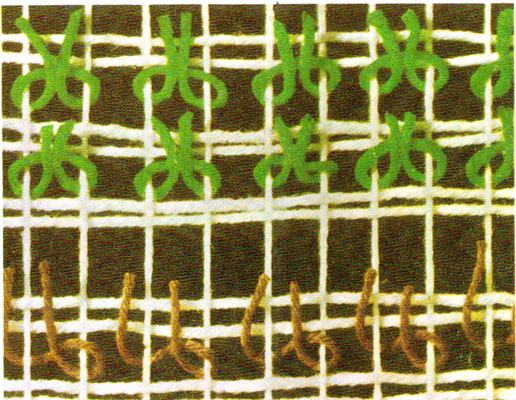
Turkish (above) and Persian knotting systems
Handmade carpets are generally called after the region or town where they are manufactured. Contemporary carpets are made in various sizes and with combinations of various materials. In some regions,the threads used in weaving and the knots may be only wool,and in some other regions,the base may be cotton and the knots wool. In other regions pure silk is used in the weaving of carpets.
Handmade carpets that can be used as rugs, wall hangings, and divan covers are manufactured in various sizes. Different names are given to carpets of different sizes. Although the names given according to size are the same for all regions, the carpets, because they are handmade, may show minor differences of dimension. While some regions manufacture carpets of all sizes, others manufacture carpets in Standard sizes. Whatever the size is, a handmade carpet brings beauty and elegance to the place where it is used. Two or three handmade carpets laid over wall to wall carpeting will add color to the rooms.
Standard dimensions in centimeters :
| Small yastık (pillow) | 40x25 |
| Yastık | 100 x 60 |
| Çeyrek | 135 x 90 |
| Seccade (prayer rug) | 180x120- 200 x 130 |
| Karyola | 220x150 |
| Kelle | 300x 200 |
| Taban | over 6 sq. meters |
| Yolluk (runner) | different sizes |
Handmade Turkish carpets are useful functional objects as well as investments for the future. When choosing among a wide range of exquisite carpets, the first criterion is falling in love at first sight. The carpet must fascinate and enrapture the buyer. However, quality is also very important, and that can vary greatly. A reputable expert dealer will carefully choose beautiful high-quality carpets and keep an extensive stock.
Handmade carpets are generally used as rugs, or as wall hangings. For a beautiful and long life, constant care is as important as the original quality. Carpets are brought to market after a special washing. Carpets which are cleaned regularly keep their bright and attractive sheen. The pile of the carpet attracts dust easily. The use of a vacuum cleaner will take away all the dust. If there is a long interval between cleanings, beating the carpet on the reverse side with a properly constructed flat reed beater is another good method that can be used. When cleaning the pile, sponge it with soapy water (not detergent). The best way to clean a very dirty carpet is to send it to a specialist carpet cleaner. When not in use, carpets should be rolled (not folded) and covered.
Technically, Turkish handmade carpets may be classified as Anatolian carpets. The carpets produced in towns and villages, and by the “Yürük” nomads reflect their art tradition. However, personal feelings and taste of the weaver may be reflected along with the traditional patterns. Handmade carpets contribute a lot to the budget of the family. Almost every region of Anatolia still produces great numbers of handmade carpets in the traditional ways, making up beautiful collections. The village folk weave carpets characteristic of the region on the looms in their houses. Besides such local centers, carpet weaving has become an industry in certain cities and towns.
High-quality handmade carpets are manufactured in houses, private workshops, or in institutions subsidized by the government. The products of these centers display a rich variety of color, design,and size. The demand for handmade carpets can only be met by the production from these centers.
The carpet weaving centers and regions and the different materials used in those centers are shown on the map on the oppositepage:

